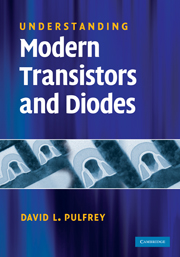Book contents
- Frontmatter
- Contents
- Preface
- 1 Introduction
- 2 Energy band basics
- 3 Electron and hole concentrations
- 4 Thermal equilibrium
- 5 Charge transport
- 6 np- and Np-junction basics
- 7 Solar cells
- 8 Light-emitting diodes
- 9 HBT basics
- 10 MOSFET basics
- 11 HJFET basics
- 12 Transistor capacitances
- 13 Transistors for high-speed logic
- 14 Transistors for high frequencies
- 15 Transistors for memories
- 16 Transistors for high power
- 17 Transistors for low noise
- 18 Transistors for the future
- Appendices
- Index
10 - MOSFET basics
Published online by Cambridge University Press: 05 June 2012
- Frontmatter
- Contents
- Preface
- 1 Introduction
- 2 Energy band basics
- 3 Electron and hole concentrations
- 4 Thermal equilibrium
- 5 Charge transport
- 6 np- and Np-junction basics
- 7 Solar cells
- 8 Light-emitting diodes
- 9 HBT basics
- 10 MOSFET basics
- 11 HJFET basics
- 12 Transistor capacitances
- 13 Transistors for high-speed logic
- 14 Transistors for high frequencies
- 15 Transistors for memories
- 16 Transistors for high power
- 17 Transistors for low noise
- 18 Transistors for the future
- Appendices
- Index
Summary
The MOSFET was the subject of a patent in 1933, but did not reach commercial maturity until about thirty years later. The delay was principally due to a lack of understanding of the importance of the oxide/semiconductor interface, and to the time taken to develop suitable fabrication procedures, notably for the growth of the thin gate oxide. Now, in the early 21st century, the science of silicon, and the art and technology of its processing into electronic devices have reached such a state of maturity that billions of Si MOSFETs are made weekly. The claim that the Si MOSFET is the most abundant object made by mankind is difficult to refute.
In this chapter the so-called ‘long-channel’ FET is considered. The basic electrostatics of the device is developed, and the DC current-voltage characteristics are derived using two models that are very widely used in the simulation of Si MOSFET integrated circuits: PSP and SPICE. PSP stands for ‘Penn-State Philips’, after the two organizations that have been largely instrumental in bringing this surface-potential model to a state of commercial viability. It is the Compact Model Council's new, industrialstandard, MOSFET model. SPICE stands for ‘Simulation Program with Integrated Circuit Emphasis’. It was originally developed by Lawrence Nagel at the University of California at Berkeley in the mid-1970s, and has evolved extensively since then. PSP is surface-potential based, whereas SPICE is threshold-voltage based.
- Type
- Chapter
- Information
- Understanding Modern Transistors and Diodes , pp. 169 - 194Publisher: Cambridge University PressPrint publication year: 2010



